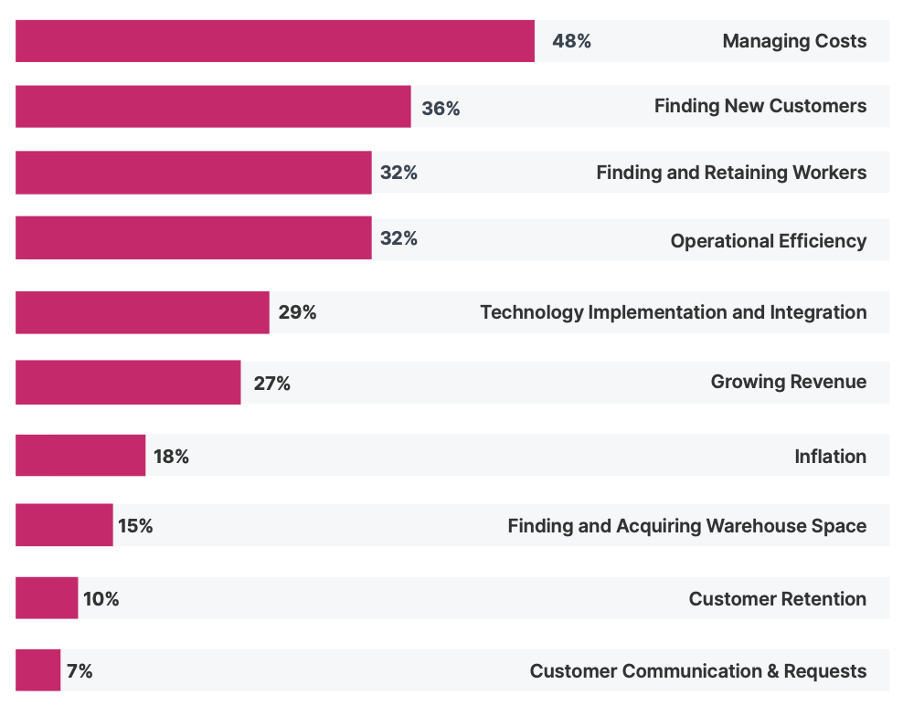The importance of pallet storage cannot be overstated. Serving as a linchpin for warehouse efficiency, a solid and well-organised pallet storage system stands out as a game-changer for logistics managers seeking streamlined operations and cost-effectiveness.
Pallet storage, with its ability to optimise warehouse space for cost-effective bulk storage, enhances warehouse organisation and expedites loading and unloading. As such, palletisation emerges as a formidable ally in the pursuit of heightened efficiency and substantial cost savings for logistics managers in practically every industry.
In this blog post, we take a close look at precisely how pallet storage improves operations, enabling logistics managers to optimise warehousing costs efficiently.
Why Efficient and Cost-effective Pallet Storage Matters
In the rapidly expanding warehousing and storage space (from 2019-2024, the industry is expected to grow at an annual rate of 2.6% to reach £29.5 billion) optimising costs and improving operational efficiency are clear imperatives to logistics managers who need reliable storage solutions for their wares.

(Image source: ibisworld.com)
Indeed, in a recent survey of logistics managers, cost management emerged as the number one top business challenge that needs to be overcome in the year ahead, cited by 48% of respondents. In joint third place, cited by 32%, was achieving operational efficiency.

(Image source: extensiv.com)
Pallet storage enables logistics professionals to overcome these challenges and more besides – which is why it’s become the industry standard solution for warehouses around the UK.
Why a Pallet Storage Solution Is the Best Strategy
There are three main ways pallet storage boosts efficiency and cost savings – optimising storage space, enhancing warehouse efficiency, and reducing operational costs.
Let’s dive into these one at a time.
Maximise Capacity by Optimising Storage Space
Pallet storage revolutionises warehouse management by ingeniously maximising storage space. The palletisation system, characterised by its use of sturdy wooden or plastic pallets, ensures efficient utilisation of both horizontal and vertical dimensions within the warehouse to make the best use of the available floor space.
In the horizontal realm, goods on pallets can be seamlessly stacked edge-to-edge, eliminating wasted space and enabling the meticulous organisation of products. This methodical arrangement not only simplifies inventory management but also facilitates rapid retrieval, minimising the time spent searching for specific items.
However, the true magic of pallet storage unfolds in the vertical space. Dynamic pallet racking systems are designed to capitalise on the often-underutilised overhead space in warehouses. By allowing goods to be stacked vertically, these systems minimise the need for expansive warehouse footprints by increasing how many pallets can be stacked per print, subsequently curbing overhead costs. The flexibility of dynamic pallet racking accommodates varying product sizes and quantities, ensuring that every inch of vertical space is efficiently employed when storing pallets.
In essence, pallet storage transforms warehouses into strategic spaces where every square foot is optimised for storage efficiency.

Enhancing Efficiency in the Warehouse Facility
Beyond spatial optimisation, pallet storage offers many further advantages for warehousing providers. To begin with, loading and unloading, too often a bottleneck in warehouse operations, are significantly accelerated with pallet storage systems. Pallets are standardised and specifically designed for forklifts. This inherent compatibility allows for the swift and secure movement of goods, reducing turnaround times and enhancing overall operational agility.
Furthermore, the systematic organisation facilitated by pallet storage plays a pivotal role in expediting inventory management. Products stored on pallets are not only easily labelled and tracked by a warehouse management system, but also follow standardised footprints, ensuring uniformity throughout the warehouse. This level of organisation translates into quicker and more accurate retrieval of goods, crucial for fulfilling orders promptly.
Pallet storage systems also contribute significantly to labour efficiency. The ease of locating and retrieving items, courtesy of the clear labelling and optimised storage layouts, reduces the need for extensive manpower. Warehouse workers can navigate their tasks with precision, while minimising errors.
In short, pallet storage transforms warehouses into hubs of operational excellence, where efficiency is not just a goal but a tangible and repeatable outcome.
Reducing Operational Costs
As a result of optimising space and enhancing efficiency, pallet storage solutions help logistics services providers in their ongoing pursuit of reducing operational costs. For starters, the inherent design of pallet systems directly contributes to lower expenditures associated with staffing, meaning any warehouse space with pallet storage you rent from warehouse providers will have low staff costs, with those savings being passed on to you when it comes to invoice time. This is because, with clearly labelled pallets and streamlined storage layouts, the need for an extensive workforce diminishes, and so pallet storage costs are reduced.
Moreover, the vertical space utilisation facilitated by pallet storage directly influences the bottom line. By efficiently stacking goods and capitalising on overhead space, businesses can minimise the necessity to pay for expansive warehouse footprints. This, in turn, results in tangible cost savings related to property leasing, maintenance, and utility expenses. In addition, the adaptability of adjustable pallet racking systems further ensures that businesses only utilise and pay for the space they require, avoiding unnecessary overhead costs associated with maintaining underutilised areas.
In all, pallet storage is not merely a spatial solution but a strategic financial tool. Through its multifaceted contributions to efficiency and labour optimisation, pallet storage serves as the cornerstone in the ongoing endeavour to reduce operational costs and fortify the financial sustainability of logistics operations.

Find the Perfect Pallet Storage Warehouse Storage Facility with FLOX
For logistics managers seeking a comprehensive solution to the intricate challenges of modern warehouse management, pallet storage emerges as fundamental, driving unparalleled efficiency, streamlining operations, and strategically cutting costs.
If you’re searching for a platform that makes it easy to find and book the best warehouse space with pallet storage facilities, your search is over. FLOX is a shared transportation and warehousing logistics platform that is dedicated to promoting efficiency, cost savings and sustainability – helping you improve operations across the board. Our platform enables warehouse managers, shippers and logistics service providers to collaborate seamlessly, driving the flow of every order and shipment. With FLOX, there’s no need to sign leases directly with warehouse or fulfilment centre owners or negotiate terms. Instead, our clients sign a standardised set of three-way Terms and Conditions between warehouse provider, FLOX and themselves, which regulates pay-as-you-go use of the warehousing space.
If you don't yet have an account, simply search for Available Storage Capacity or list your Logistics Services with no monthly fees.
Sign up for the FLOX platform and start shaping the future of logistics today.
FAQ
How much does it cost to store a pallet in a warehouse?
In the UK, the cost to store a pallet in a warehouse typically ranges from £1.50 to £5.00 per pallet per week, although this can vary based on several factors. The specific rate may depend on the total number of pallets being stored, with potential discounts available for larger quantities. It's important to note that these rates might not include additional fees, such as shunting fees, which are charged for loading and unloading pallets from transport vehicles to the storage racks.
The location of the warehouse can also significantly impact costs, as facilities in busy urban areas generally command higher prices compared to those in suburban or remote locations. Additional factors like the type of pallets being stored—standard CHEP or euro pallets—and any special storage requirements may also influence the overall storage expenses.
How are pallets stored in warehouses?
Pallets are stored in warehouses using several methods, each suited for different needs and types of goods. Here are some common ways pallets are stored.
Selective Racking: This is the most common method where pallets are stored on racks that allow direct access to each pallet. It maximises accessibility and is ideal for a variety of products.
Pallet Flow Racks: These use gravity to move pallets from the back of the rack to the front, allowing for high-density storage and easy access to the first-in, first-out (FIFO) inventory system.
Push Back Racks: In this system, pallets are loaded onto inclined rails. When a new pallet is loaded, it pushes the previous pallets back, allowing for easy access to the first pallet.
Double-Deep Racking: This method stores pallets two deep, effectively doubling storage capacity but requiring special equipment for accessing deeper pallets.
Block Stacking: This is a more straightforward and cost-effective method where pallets are stacked directly on the warehouse floor in designated lanes or blocks. The height of the stack is determined by factors such as pallet size, weight and type.
Drive-In/Drive-Through Racking: These systems allow forklifts to drive directly into the racking system. Drive-in systems have a single entry point for loading and unloading, while drive-through systems allow access from both sides, enhancing accessibility.
Mobile Racking: This type of racking can be moved to create aisles only when needed, maximising storage space and allowing for efficient access to pallets.
Cantilever Racking: While typically used for storing long items, it can also be adapted for certain palletised goods, particularly for materials that don’t stack easily.
Shared Warehousing: This approach enables multiple users to share warehouse space and resources, allowing for flexible storage solutions without the need for dedicated space.
On-Demand Warehousing: Some warehousing services provide flexible, scalable storage options that can be adjusted based on seasonal demands or unforeseen circumstances. This model allows businesses to access unused pallet storage space as needed.
By employing these methods, warehouses can optimise space utilisation, enhance operational efficiency, and ensure the safety and accessibility of stored goods.



